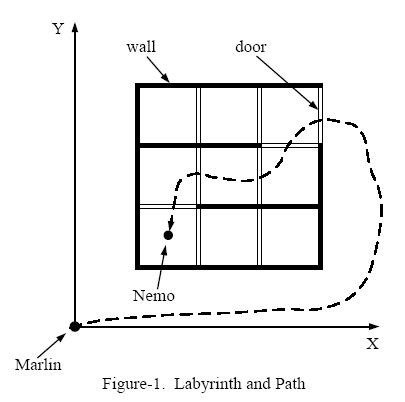Finding Nemo
| Time Limit: 2000MS | Memory Limit: 30000K | |
| Total Submissions: 9778 | Accepted: 2334 |
Description
Nemo is a naughty boy. One day he went into the deep sea all by himself. Unfortunately, he became lost and couldn't find his way home. Therefore, he sent a signal to his father, Marlin, to ask for help.
After checking the map, Marlin found that the sea is like a labyrinth with walls and doors. All the walls are parallel to the X-axis or to the Y-axis. The thickness of the walls are assumed to be zero.
All the doors are opened on the walls and have a length of 1. Marlin cannot go through a wall unless there is a door on the wall. Because going through a door is dangerous (there may be some virulent medusas near the doors), Marlin wants to go through as few doors as he could to find Nemo.
Figure-1 shows an example of the labyrinth and the path Marlin went through to find Nemo.

We assume Marlin's initial position is at (0, 0). Given the position of Nemo and the configuration of walls and doors, please write a program to calculate the minimum number of doors Marlin has to go through in order to reach Nemo.
After checking the map, Marlin found that the sea is like a labyrinth with walls and doors. All the walls are parallel to the X-axis or to the Y-axis. The thickness of the walls are assumed to be zero.
All the doors are opened on the walls and have a length of 1. Marlin cannot go through a wall unless there is a door on the wall. Because going through a door is dangerous (there may be some virulent medusas near the doors), Marlin wants to go through as few doors as he could to find Nemo.
Figure-1 shows an example of the labyrinth and the path Marlin went through to find Nemo.

We assume Marlin's initial position is at (0, 0). Given the position of Nemo and the configuration of walls and doors, please write a program to calculate the minimum number of doors Marlin has to go through in order to reach Nemo.
Input
The input consists of several test cases. Each test case is started by two non-negative integers M and N. M represents the number of walls in the labyrinth and N represents the number of doors.
Then follow M lines, each containing four integers that describe a wall in the following format:
x y d t
(x, y) indicates the lower-left point of the wall, d is the direction of the wall -- 0 means it's parallel to the X-axis and 1 means that it's parallel to the Y-axis, and t gives the length of the wall.
The coordinates of two ends of any wall will be in the range of [1,199].
Then there are N lines that give the description of the doors:
x y d
x, y, d have the same meaning as the walls. As the doors have fixed length of 1, t is omitted.
The last line of each case contains two positive float numbers:
f1 f2
(f1, f2) gives the position of Nemo. And it will not lie within any wall or door.
A test case of M = -1 and N = -1 indicates the end of input, and should not be processed.
Then follow M lines, each containing four integers that describe a wall in the following format:
x y d t
(x, y) indicates the lower-left point of the wall, d is the direction of the wall -- 0 means it's parallel to the X-axis and 1 means that it's parallel to the Y-axis, and t gives the length of the wall.
The coordinates of two ends of any wall will be in the range of [1,199].
Then there are N lines that give the description of the doors:
x y d
x, y, d have the same meaning as the walls. As the doors have fixed length of 1, t is omitted.
The last line of each case contains two positive float numbers:
f1 f2
(f1, f2) gives the position of Nemo. And it will not lie within any wall or door.
A test case of M = -1 and N = -1 indicates the end of input, and should not be processed.
Output
For each test case, in a separate line, please output the minimum number of doors Marlin has to go through in order to rescue his son. If he can't reach Nemo, output -1.
Sample Input
8 9 1 1 1 3 2 1 1 3 3 1 1 3 4 1 1 3 1 1 0 3 1 2 0 3 1 3 0 3 1 4 0 3 2 1 1 2 2 1 2 3 1 3 1 1 3 2 1 3 3 1 1 2 0 3 3 0 4 3 1 1.5 1.5 4 0 1 1 0 1 1 1 1 1 2 1 1 1 1 2 0 1 1.5 1.7 -1 -1
Sample Output
5 -1
Source
写的真的非常好!!!
很经典的BFS搜索 走迷宫选取经过门最少的路线,这题POJ测试数据设计不全面,changeDir数组赋值错误也可以过。。。
主要图的数据结构存储方式和算法实现参考了http://blog.csdn.NET/bobten2008/article/details/5093307
(1)首先是建图, 由于输入给的都是线段, 但是我们平常处理这类问题都是转换为网格来做的, 因此需要将线段转换为网格.转化的方法是对于每个格子,用其左上角点的坐标来表示这个格子。如果其左上角点的坐标是[i][j],那么这个格子就表示为[i][j].将其四周边界的四条线段归这个格子管.即为每个格子建一个数组round[i][j][4],第三维的四个位置分别表示这四条线段的类型(0-3分别对应上下左右): 数组元素的值0表示空气,1表示墙,2表示是一扇门,这样这个模型就建立好了.
(2)其次是bfs的起始点选为Nemo所在的位置,注意要将这个浮点点位置转化为格子的坐标.转化的方法很简单.对于x坐标取整即可,对于y坐标取整+1即可,比如Nemo所在位置为[1.2, 1.3]那么转化为格子的坐标即为:[1, 2].这个坐标即位bfs遍历的起始点(3)遍历的时候如果所走的方向是墙,则不可走.如果是门则将当前总的steps数+1,如果为空气,steps数不变.另外一点就是如何判重.判重不能简单地记录有没有被访问过,而是需要记录到当前格子的最小步骤.如果当前总步骤数小于当前格子的最小步骤数,则更新其最小步骤数并将这个格子加入队列中.
(4)遍历的终止位置即为题目中的出发位置[0, 0]
Source Code
| Problem: 2049 | User: yangliuACMer | |
| Memory: 1160K | Time: 250MS | |
| Language: C++ | Result: Accepted |






















 425
425











 被折叠的 条评论
为什么被折叠?
被折叠的 条评论
为什么被折叠?








